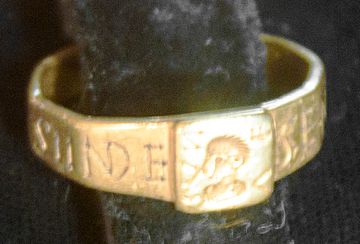Ring of Silvianus facts for kids
The Vyne Ring, also called the Ring of Silvianus, is a special gold ring from around the 4th century AD. It was found in a field near Silchester, England, in 1785. The ring first belonged to a British Roman named Silvianus. It seems someone named Senicianus stole it, and Silvianus then put a curse on Senicianus.
After it was found, the ring became the property of the Chute family. Their country house, The Vyne, is also in Hampshire and is now looked after by the National Trust. The ring was put on display there in April 2013.
In 1929, during digs at a Roman temple site in Lydney Park, an archaeologist named Sir Mortimer Wheeler found out more about the curse. Wheeler talked with J. R. R. Tolkien about the name of the god mentioned in the curse. Because of this, some people think the ring and its curse might have given Tolkien ideas for the One Ring in his famous books, The Hobbit and The Lord of the Rings.
Contents
What Does the Vyne Ring Look Like?
The Ring of Silvianus is quite large for a ring. It is 25 mm (1 in) wide and weighs 12 g (0.4 oz). It might have been worn over a glove. The ring's band has ten flat sides. It holds a square stone, called a bezel, which has a picture of the goddess Venus carved into it.
Next to the picture are the letters "VE" on one side and "NVS" on the other. These letters are carved in mirror writing. This means they look backward until the ring is used as a signet ring. When pressed into wax to make a seal, the picture and letters would appear the right way around.
The ring also has words carved into its band: "SENICIANE VIVAS IIN DE". This writing has two mistakes. The letter "I" is written twice, and there wasn't enough space for the last letter "O". The message should have been "VIVAS IN DEO". This was a common saying for Roman Christians, meaning "live in God".
The Ring's Journey Through Time
The Ring of Silvianus was found in 1785 in a farm field near Silchester. Silchester was a Roman town and many old things have been found there. We don't know exactly how the ring ended up at The Vyne. People think the farmer who found it sold it to the Chute family. The Chutes were known to be interested in history and old objects. In 1888, the owner of The Vyne, Chaloner Chute, wrote about the ring in a book about the house.
The Curse Tablet Discovery
In the early 1800s, a lead tablet was found at a Roman temple site in Lydney Park, Gloucestershire. This site is about 80 miles (130 km) from The Vyne. These tablets are known as "curse tablets" or defixiones. The tablet had a curse written on it:
|
DEVO NODENTI SILVIANVS ANILVM PERDEDIT DEMEDIAM PARTEM DONAVIT NODENTI INTER QVIBUS NOMEN SENICIANI NOLLIS PETMITTAS SANITATEM DONEC PERFERA VSQVE TEMPLVM DENTIS |
For the god Nodens. Silvianus has lost a ring and has given half its worth to Nodens. Among those named Senicianus, do not allow good health until it is returned to the temple of Nodens. |
In 1929, archaeologist Sir Mortimer Wheeler was digging at the Lydney site. He noticed a link between the ring, which had the name Senicianus, and the curse tablet, which also mentioned Senicianus. Wheeler asked J.R.R. Tolkien, who was a professor at Oxford University, to study the name "Nodens" from the curse.
For a long time, the Ring of Silvianus stayed in the library at The Vyne and was not well known. But in April 2013, it was put on public display for the first time. It was part of its own exhibition, which also included a copy of the curse tablet's writing.
The Ring's Connection to J.R.R. Tolkien
Many people believe that Sir Mortimer Wheeler and J.R.R. Tolkien talked about the Vyne Ring. Wheeler knew about the ring, and it's thought he would have mentioned it during their discussions about the god Nodens and the curse tablet. However, there is no direct proof of this conversation. Some also think that other old sites in the Lydney area, like an Iron Age Roman fort, might have given Tolkien ideas for his stories.
The One Ring is a very important part of Tolkien's books, The Hobbit (published in 1937) and The Lord of the Rings (published in 1954). In Tolkien's legendarium, which is the world Tolkien created, the evil Dark Lord Sauron made the One Ring. He wanted to use it to control everyone in Middle-earth.
The Tolkien Society helped set up the "Ring Room" at The Vyne. This room has the Ring of Silvianus in a special spinning display case. It also shows a first edition of The Hobbit and a copy of the curse tablet. Outside, there is even a Middle-earth adventure playground. Lynn Forest-Hill from the Tolkien Society was very happy to find a real-world object that might have inspired the One Ring. She said that all other ideas for the ring had come from books or old legends, like the Ring of the Nibelungs.


